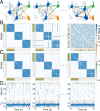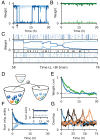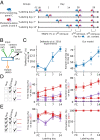Drifting assemblies for persistent memory: Neuron transitions and unsupervised compensation
- PMID: 34772802
- PMCID: PMC8727022
- DOI: 10.1073/pnas.2023832118
Drifting assemblies for persistent memory: Neuron transitions and unsupervised compensation
Abstract
Change is ubiquitous in living beings. In particular, the connectome and neural representations can change. Nevertheless, behaviors and memories often persist over long times. In a standard model, associative memories are represented by assemblies of strongly interconnected neurons. For faithful storage these assemblies are assumed to consist of the same neurons over time. Here we propose a contrasting memory model with complete temporal remodeling of assemblies, based on experimentally observed changes of synapses and neural representations. The assemblies drift freely as noisy autonomous network activity and spontaneous synaptic turnover induce neuron exchange. The gradual exchange allows activity-dependent and homeostatic plasticity to conserve the representational structure and keep inputs, outputs, and assemblies consistent. This leads to persistent memory. Our findings explain recent experimental results on temporal evolution of fear memory representations and suggest that memory systems need to be understood in their completeness as individual parts may constantly change.
Keywords: associative memory; cell assemblies; neural representations; representational drift; synaptic remodeling.
Conflict of interest statement
The authors declare no competing interest.
Figures








Similar articles
-
The Interplay of Synaptic Plasticity and Scaling Enables Self-Organized Formation and Allocation of Multiple Memory Representations.Front Neural Circuits. 2020 Oct 7;14:541728. doi: 10.3389/fncir.2020.541728. eCollection 2020. Front Neural Circuits. 2020. PMID: 33117130 Free PMC article.
-
Stable memory with unstable synapses.Nat Commun. 2019 Sep 30;10(1):4441. doi: 10.1038/s41467-019-12306-2. Nat Commun. 2019. PMID: 31570719 Free PMC article.
-
Drift of neural ensembles driven by slow fluctuations of intrinsic excitability.Elife. 2024 May 7;12:RP88053. doi: 10.7554/eLife.88053. Elife. 2024. PMID: 38712831 Free PMC article.
-
[Acquiring new information in a neuronal network: from Hebb's concept to homeostatic plasticity].J Soc Biol. 2008;202(2):143-60. doi: 10.1051/jbio:2008018. Epub 2008 Jun 13. J Soc Biol. 2008. PMID: 18547512 Review. French.
-
Synaptic clustering within dendrites: an emerging theory of memory formation.Prog Neurobiol. 2015 Mar;126:19-35. doi: 10.1016/j.pneurobio.2014.12.002. Epub 2015 Jan 8. Prog Neurobiol. 2015. PMID: 25576663 Free PMC article. Review.
Cited by
-
Reconstructing computational system dynamics from neural data with recurrent neural networks.Nat Rev Neurosci. 2023 Nov;24(11):693-710. doi: 10.1038/s41583-023-00740-7. Epub 2023 Oct 4. Nat Rev Neurosci. 2023. PMID: 37794121 Review.
-
The brain in motion: How ensemble fluidity drives memory-updating and flexibility.Elife. 2020 Dec 29;9:e63550. doi: 10.7554/eLife.63550. Elife. 2020. PMID: 33372892 Free PMC article. Review.
-
Sensory experience steers representational drift in mouse visual cortex.Nat Commun. 2024 Oct 23;15(1):9153. doi: 10.1038/s41467-024-53326-x. Nat Commun. 2024. PMID: 39443498 Free PMC article.
-
Cortical cell assemblies and their underlying connectivity: An in silico study.PLoS Comput Biol. 2024 Mar 11;20(3):e1011891. doi: 10.1371/journal.pcbi.1011891. eCollection 2024 Mar. PLoS Comput Biol. 2024. PMID: 38466752 Free PMC article.
-
Assemblies, synapse clustering, and network topology interact with plasticity to explain structure-function relationships of the cortical connectome.Elife. 2025 Jul 3;13:RP101850. doi: 10.7554/eLife.101850. Elife. 2025. PMID: 40608402 Free PMC article.
References
-
- Rumpel S., Triesch J., The dynamic connectome. e-Neuroforum 22, 48–53 (2016).
-
- Humeau Y., Choquet D., The next generation of approaches to investigate the link between synaptic plasticity and learning. Nat. Neurosci. 22, 1536–1543 (2019). - PubMed
Publication types
MeSH terms
LinkOut - more resources
Full Text Sources
Medical

